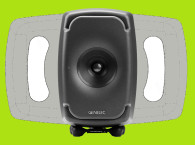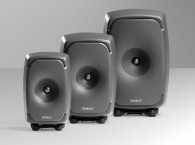Introduced during the 137th Audio Engineering Society (AES) Convention in Los Angeles, CA, the new Genelec 8351A Acoustically Coaxial Smart Active Monitor (SAM) System is a tri-amplified studio near-field monitor with an ingenious design that introduces enhanced directivity control at lower frequencies in a relatively small speaker. This brilliant design reflects the Finish brand’s “outside-the-box” thinking and will help improve reference audio in recording studios.
Introduction by João Martins and Vance Dickason
Article by Aki Mäkivirta, Jussi Väisänen, and Ilpo Martikainen
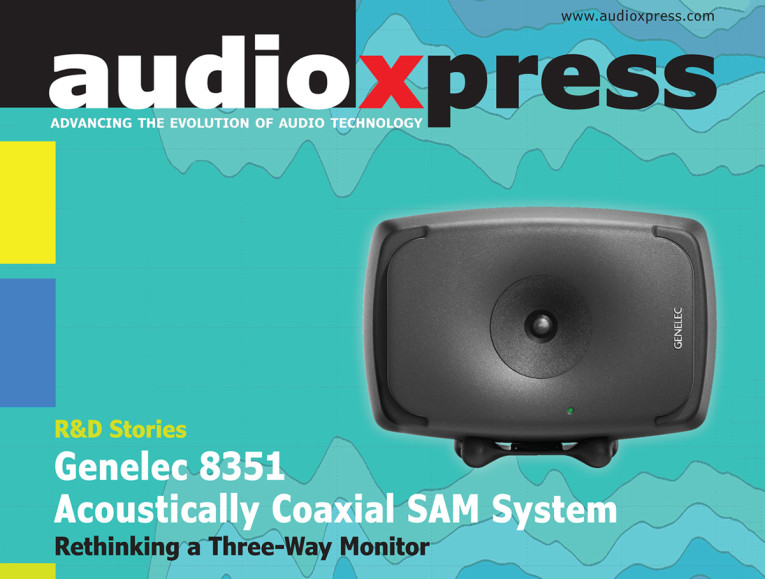
The mid- and high-frequency section of this three-way design is comprised of a coaxial 5” midrange with a 0.75” tweeter. The clever part, however, is the woofer section in which Genelec’s engineering staff incorporated two 8.5” × 4” slot-loaded racetrack-shaped low-frequency transducers at the top and bottom of the enclosure. While this intuitively looks as if it might not be optimal in both horizontal and vertical planes, the opposite is true (see Photo 1).
When we look at the horizontal isobaric directivity plot shown in Figure 1 and the vertical isobaric directivity plot shown in Figure 2, they are reasonably matched in performance. Obviously, it is important for a studio monitor to work equally well in both possible orientations. However, most monitors do not, so this is a significant accomplishment for Genelec.
Every sub-system in the 8351—electronics, the drivers, and the mechanical assembly—is designed by Genelec’s R&D team and built entirely in-house at the Genelec factory in Iisalmi, Finland, to ensure accuracy and reliability. In this article, we share the design process as explained by the authors—Aki Mäkivirta, Jussi Väisänen, and Ilpo Martikainen — in their paper “Design of an Acoustically Coaxial Three-Way Monitor,” which was presented at the 28th Tonmeistertagung VDT International Convention, November 2014. The Genelec 8351 SAM System was initially introduced the prior month, in October 2014, at the 137th AES Convention in Los Angeles (see Photo 2).
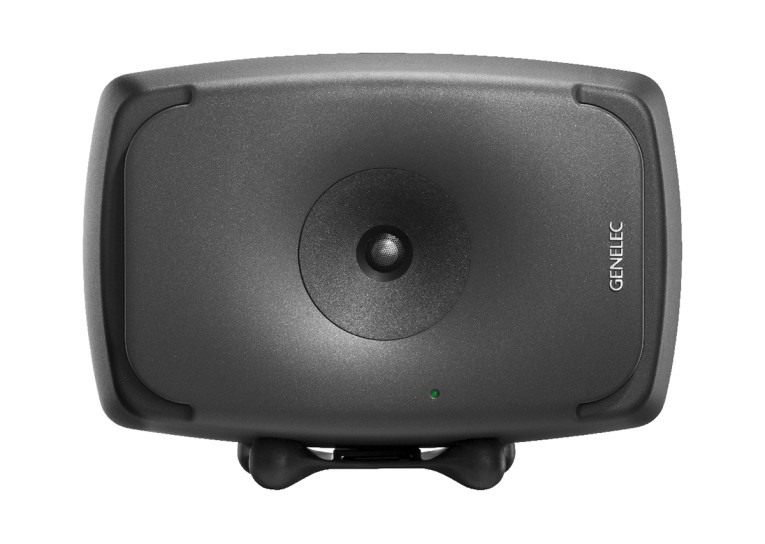


The Acoustically Coaxial Design
The three-way acoustically coaxial monitor uses a minimum diffraction co-axial midrange/tweeter driver seated in a directivity control waveguide. The innovative solution allows acoustically concealing the woofers seated in the front enclosure under the waveguide, creating a large continuous front baffle surface for mid and high frequencies.
The two woofers, placed at the enclosure ends, acoustically combine to extend controlled directivity to bass frequencies. This acoustically concealed woofer system enables a compact enclosure with controlled directivity across the full audio band and directivity control on par with physically larger studio monitors. Horizontal and vertical characteristics are similar, enabling use in any orientation. For example, to minimize console top reflections, the monitor is vertically placed for high vertical directivity. If the side walls are close, the monitor can be horizontally mounted, reducing acoustic interaction with the walls. Other room influences can be minimized with smart signal processing features.
This design responds to the current needs of today’s recording and mixing environments, which are shrinking in size and becoming more uneven in their frequency responses. At the same time, the production work must be done within the constraints of tighter budgets, yet with increasing quality requirements for the end product.
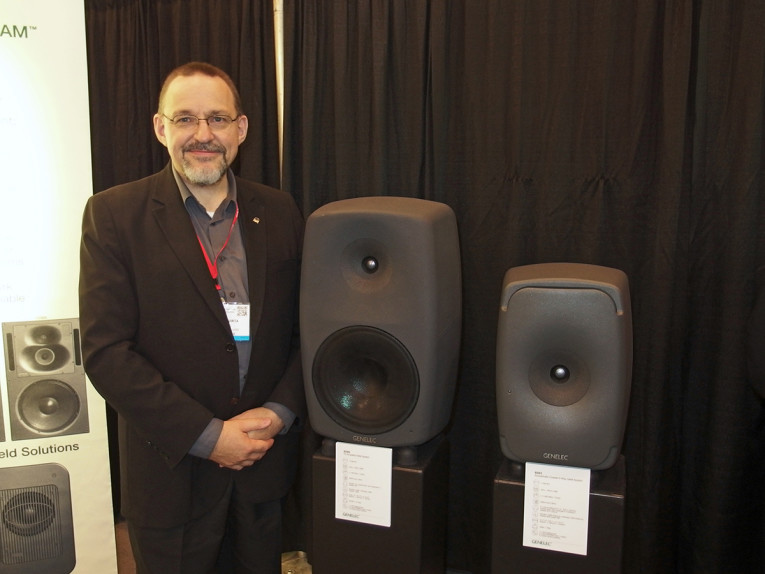
More coloration, larger differences between rooms, multiple types of production and repurposing of rooms during the day or week require reproduction systems with high neutrality for accurate editing work, and high sound pressure level (SPL) capability when required (see Photo 3).
Although a two-way active monitor is the industry’s ubiquitous reliable workhorse, a three-way monitor design presents the performance optimum in many ways. A three-way monitor is needed for applications where:
• Very high-quality audio is required
• Accurate sound stage imaging is wanted
• It is necessary to hear subtle acoustic details, even at high SPL
• Accurate control of monitor directivity is necessary
The three-way monitor design enables refined selection and optimization of individual driver characteristics (i.e., sensitivity, linearity, output capacity, and directivity) because of the narrower frequency range for each driver (see Photo 4).
Optimal crossover frequencies can be chosen based on the acoustical constraints given by the drivers and the enclosure characteristics. A larger surface area of the waveguide can enhance directivity and achieve the best performance in the presence of challenging room acoustics typical of small or acoustically compromised rooms.
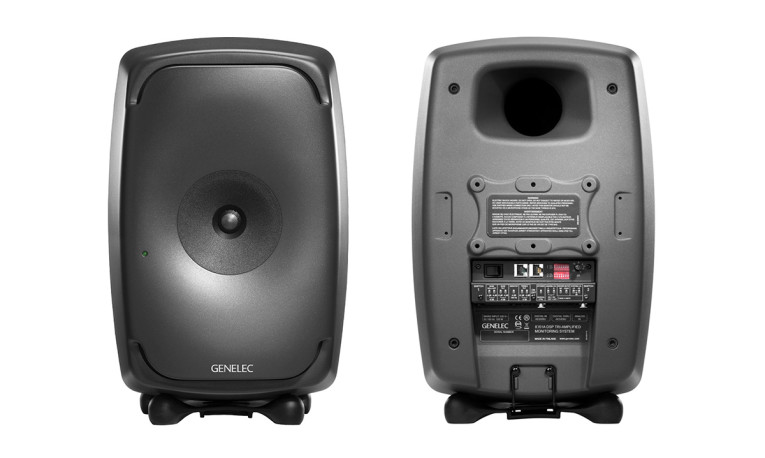
Benefit of Coaxial Monitor Concept
The coaxial driver arrangement has an important acoustic benefit. A multi-way monitor loudspeaker has two drivers simultaneously reproducing sound across the crossover range of frequencies. A conventional multi-way design has driver locations distributed across the front baffle. The summation of the outputs from any two drivers has been designed to be in phase in the primary listening direction (the acoustical axis). When the two outputs are in phase, the combined system output remains flat. For off-axis locations, the two drivers are not in phase because the distances to the drivers have changed from the design geometry. This can produce strong coloration in audio. The frequency of this coloration also changes when the listener moves further off axis. Placing drivers coaxially can eliminate this coloration for off-axis positions as the geometry remains the same for the off-axis positions.
The crossover performance has been further improved by time-aligning the two coaxially constructed drivers at the crossover frequency, producing the benefit of maintaining the time domain waveforms. This is particularly important for driver constructions with which the physical height of the tweeter and midrange drivers are significantly different.
Evolution of the Coaxial Driver
The concept of implementing a multi-way driver system coaxially is not new. In the 1940s, Altec Lansing launched the 601 coaxial driver with a section horn tweeter coaxially located in a 12” woofer. This was followed closely by the Tannoy Dual Concentric design. By the 1970s, the UREI 813 three-way coaxial monitor became popular in audio monitoring.
When the woofer cone surface forms the waveguide for the high-frequency radiator, intermodulation distortion tends to be larger than it is for designs with a fixed horn located in the woofer’s apex. The intermodulation can be reduced by directing low frequencies to a separate woofer driver, using the coaxial driver as a midrange-tweeter radiator. The intermodulation distortion problems typical for these designs can be significantly reduced with a physically displaced woofer in a three-way arrangement.
The fixed horn tweeter coaxial designs suffer from diffraction of sound around the horn’s mouth. The sound diffracting around the horn’s mouth travels to the woofer cone, then reflects backward and sums with the direct sound with a fixed delay and frequency specific level, creating sound coloration.
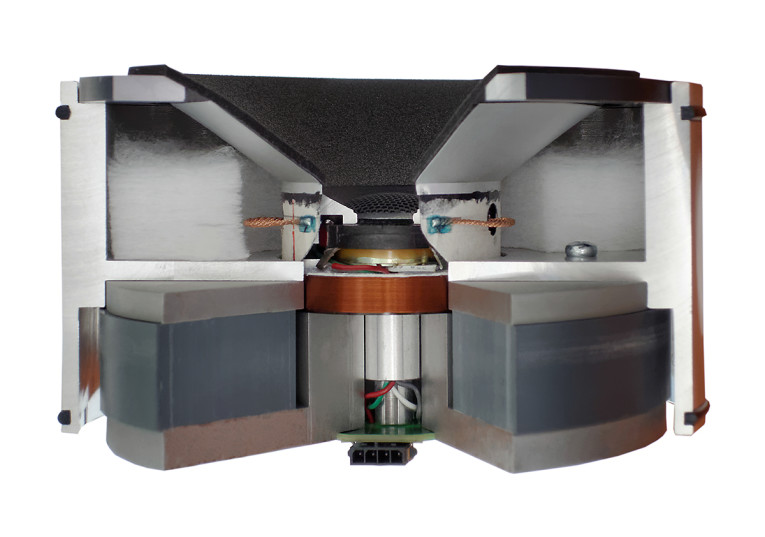
When we look at the small three-way monitoring products available today, we see four primary design types. The first design type is the conventional non-coaxial driver arrangement, in which individual drivers are arranged in the loudspeaker enclosure’s front baffle, displaced from each other. When three drivers are crammed onto the compact front baffle area, typically there is no surface area left for directivity control in the midrange and woofer frequencies. It becomes difficult to arrange the drivers on the front baffle so that crossover coloration problems at the two crossover frequencies can be avoided for off-axis sound.
The second type is the approximately coaxial driver arrangement, which has an island containing a conventional tweeter and midrange driver on top of a woofer. In some approximately coaxial systems, all three drivers have been stacked but the driver axes may not be coaxial. Approximately coaxial designs allow smaller physical size for the monitor’s front baffle but usually have problems with the drivers’ height differences and the delayed addition of the diffracted audio to the direct radiation, coloring on-axis audio. Directivity matching can be problematic and cause coloration issues for the off-axis audio.
Today, the coaxial operating principle is enjoying a degree of renaissance as coaxial drivers can implement physically smaller multi-way monitoring systems. Both coaxial driver construction principles can be found in three-way monitors. The two coaxial driver technologies used in three-way arrangements include variants of the concentric tweeter-midrange driver and the horn-loaded tweeter system (fixed tweeter horn) suspended coaxially with the midrange driver.
However, several characteristic problems remain with three-way monitor designs that use coaxial drivers. It is difficult to optimally design the seating and surface shapes of the coaxial driver. This can lead to poor control of diffraction and colorations. Although the concentric arrangement tendency to cause intermodulation distortions can be alleviated by using a separate woofer, it is usually not possible to sufficiently optimize the midrange cone shape to make the midrange work as a high-performance waveguide for the tweeter. Seating of the midrange cone to the driver chassis and the joint between the tweeter and the midrange typically introduce diffracting edges in the design.
The fixed horn tweeter approach for a coaxial driver reduces the intermodulation problems but has other challenges. There is usually some frequency dependent amount of sound diffracted around the edges of the tweeter horn’s mouth opening. This sound energy takes time to travel to the midrange cone surface and is then reflected back, and eventually sums with the direct tweeter sound a short time later. This introduces SPL direction and frequency-dependent variations, making it challenging to achieve flat frequency response on more than one axis for these designs.
Today’s coaxial three-way monitors try to alleviate the inherent problems of the coaxial drivers by digital signal processing. Although it can improve the flatness of the frequency response, signal processing cannot correct for problems with directivity control, colorations in the off-axis positions, or the tendency of a coaxial driver to produce distortion.
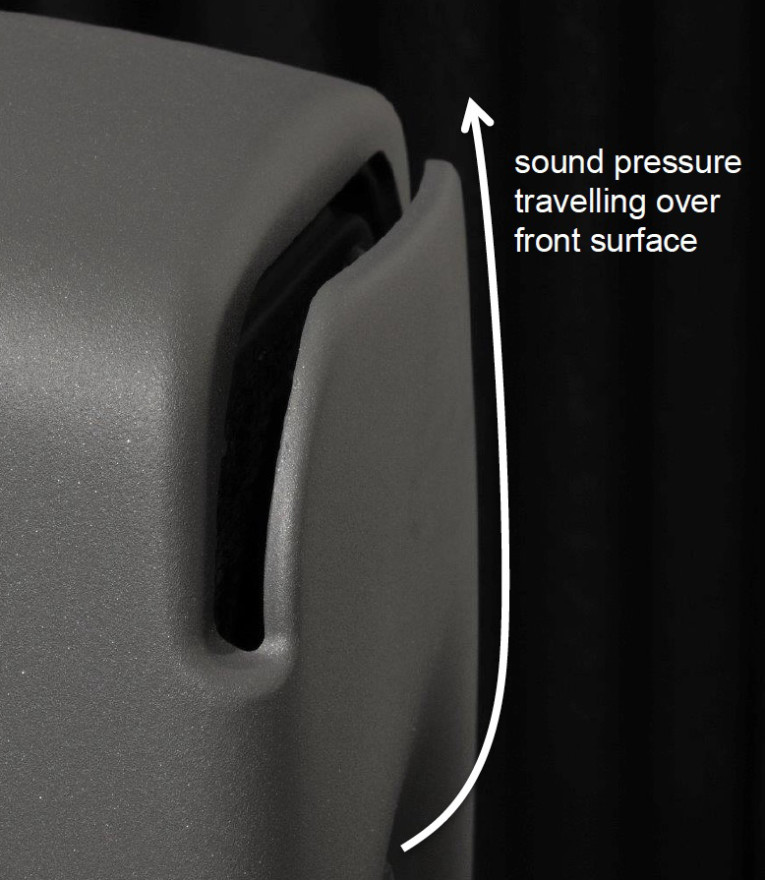
Acoustically Concealed Woofers
Genelec’s novel approach consists of using a new acoustically coaxial minimum diffraction three-way monitor loudspeaker design. This design uses the entire front baffle as a directivity control waveguide by hiding two woofer drivers under the front baffle.
The monitor uses two 215 mm × 100 mm (8.5” × 4”) woofers displaced out on the two ends of the enclosure front. The woofers are housed in a shared bass reflex enclosure having a reflex port opening to the enclosure’s back. The total woofer surface area and the magnetic motor capacity have been maximized. The woofers occupy the remaining front baffle surface outside the minimum diffraction coaxial (MDC) driver unit, hidden under the front surface (see Figure 3). The total woofer diaphragm area is close to that of a 255 mm (10”) woofer.
The two woofers are located under acoustically optimized extensions of the front baffle. Woofer radiation happens through the openings, one for each woofer. This acoustical concealment is the cornerstone, enabling a compact coaxial monitor with good directivity control. Two spaced woofers create acoustic directivity extending to woofer frequencies.
The directivity produced by the concealed woofer concept is considerable (see Figure 4). The distance between the centers of the two woofers is 268 mm. However, the radiation occurs out of two acoustically optimized slots. These two slots are spaced with a distance of their acoustic centers of 380 mm.
This corresponds to 0.56 wavelengths at the highest operating frequency, which is 490 Hz at the woofer-to-midrange crossover point. This distance is short so the system of two woofers has directivity characteristics similar to one large round woofer driver with a diameter of 457 mm (18”) in the vertical plane. On the horizontal plane, the directivity is determined by the longer axis diameter of the oval woofers.

Directivity Control
Matching directivities of the drivers in the acoustically coaxial three-way monitor improves the system performance. The woofer system’s combined acoustic axis created by the two spaced drivers radiating though the slot openings coincides with the acoustic axis of the minimum diffraction tweeter-midrange coaxial driver. This matching creates an acoustically coaxial three-way system with the added benefit of a woofer system with controlled directivity (see Figure 5).
The diffraction-free coaxial driver blending with the directivity control waveguide of the enclosure front creates a continuous optimized acoustic surface for the high frequencies radiated by the tweeter as well as the midrange. The coaxial driver design does not have any acoustic discontinuity, such as a gap or a step change of the acoustic surface profile, either at the joint between the tweeter, the midrange inside edge, or at the outer edge of the midrange. The coaxial driver functions without acoustic diffraction effects through its operating frequency range.
The large waveguide enables good control of directivity across the operating frequency range of the tweeter-midrange system. The waveguide geometry has been optimized to minimize sound coloring diffractions. The compact three-way design presents a waveguide surface area equal to that found in large size three-way main studio monitors. The directivity control remains down to 300 Hz in the vertical direction and down to 700 Hz in the horizontal direction (see Figure 6). Considering the enclosure’s compact external dimensions, the monitor has excellent ability to control directivity, typically only found in monitors with significantly larger enclosure sizes.
Characteristics
The new acoustically coaxial three-way design uses two woofers 215 x 100 mm (8.5” x 4”) and a minimum diffraction coaxial driver that contains a 130 mm (5”) midrange and 19 mm (0.75”) aluminum dome tweeter. These are powered by two 150-W Class-D amplifiers (a woofer and a midrange) and one 120-W Class-AB amplifier (tweeter). The crossover frequencies are 490 Hz and 2.6 kHz.
The external dimensions are similar to a typical two-way, with a 452 mm (17”) height, a 287 mm (11”) width, and a 278 mm (11”) depth. Analog and digital audio sources can be directly connected to the monitor. The analog input is capable of accepting signals up to +24 dBu. The analog input is converted for signal processing and reproduction. Monitoring of digital audio in AES/EBU format supports sampling rate up to 192 kHz.
Digital audio is sample rate converted to ensure synchronization with all sources. An AES/EBU thru output provides daisy-chaining to more monitors. The digital audio AES/EBU and analog audio input signals are filtered with digital signal processing at an internal 96-kHz sampling rate. There is a 48-kHz-wide audio path from the inputs to the acoustic output. Input-to-output system latency is approximately 5 ms in mid and high frequencies.
The low corner frequency of the coaxial monitor system is 32 Hz. Signal processing has an electronic bandwidth of almost 50 kHz, allowing system equalization to extend above the audible range (see Figure 7). The high corner frequency is typically 30–40 kHz (±6 dB). The on-axis frequency response shown in Figure 1 and Figure 2 is flat to ±1.5 dB (38 Hz to 21 kHz).
Because of the large directivity control waveguide effectively covering the monitor’s entire front baffle, the frequency response neutrality can also be maintained for the off-axis directions. This implies that the color of sound radiated into the room, and audible as the late energy in the room, also maintains a relatively neutral character.
In a typical monitoring environment, the instantaneous peak output SPL exceeds 123 dB (referenced at 1 m) per a pair of monitors. For an individual monitor, the maximum short-term SPL measured in half space, averaged within the frequency band 100 Hz to 3 kHz exceeds 110 dB (referenced to 1 m distance). The long-term maximum SPL is limited by the overload protection to about 105 dB SPL.
The acoustically coaxial three-way monitor also features flexible signal processing tools (Smart Active Monitoring). These tools add a layer of intelligence to the monitors. The monitors connect to a control network. All aspects of the settings in a multi loudspeaker system can be adjusted at the listening position. Automated aligning of monitors and subwoofers with regard to level, timing, and equalization of room responses can reduce room influence on sound and improve accuracy of monitoring.
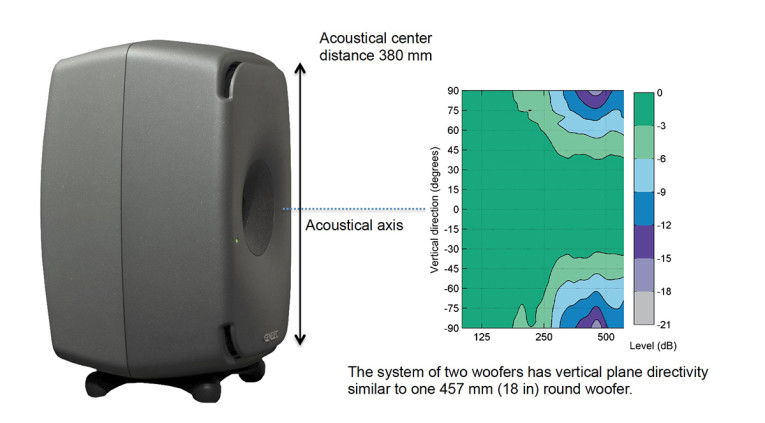
Performance
The performance of the proposed acoustically coaxial monitor construction was evaluated against the typical performance of the established implementations of compact three-way monitors. A multi-tone measurement signal was used. Multitone measurements can provide relatively realistic measurements of the overall linearity because the signal is a complex multi-frequency signal containing a wide bandwidth, essentially presenting a load similar to a realistic wideband audio signal. The test signal contains 30 tones distributed evenly on a log frequency scale across the audible range, from 21 Hz to 20 kHz.
The case examples have included the typical technologies currently applied in compact three-way monitor designs. The technologies were represented by case example products of the concentric type tweeter-midrange system (A), a conventional separate driver arrangement (B), approximately coaxial approach with the tweeter located on an island suspended over the tweeter and a displaced woofer (C), a fixed horn-type tweeter coaxial with the midrange driver (D), and the proposed acoustically coaxial minimum diffraction driver system (E) shown in Figure 8. It is worth noting that in this case study, technologies A and D were in fact two-way systems. This may affect the distortion figures for these two cases.
The multitone distortion to audio signal ratio was measured for each of the case examples and the distortion within the frequency range 100 Hz to 10 kHz was considered. It is worth noting that when the frequency range was limited to 500 Hz to 10 kHz, the results remained relatively the same. The signal level for Cases B to E was 89 dB SPL, and for Case A, 84 dB SPL.
It may also be noted that the conventional separate driver three-way system did not show any advantage in terms of the intermodulation distortion although theoretically, it should have an advantage over the coaxial systems. Approximately coaxial, fixed horn coaxial and the proposed technology were similar in terms of the complex intermodulation performance but will show clear differences in terms of the off-axis coloration and on-axis frequency response flatness. As the case study examples are believed to display state-of-the-art performance, it could be established that the proposed method showed favorable performance in terms of distortion characteristics.
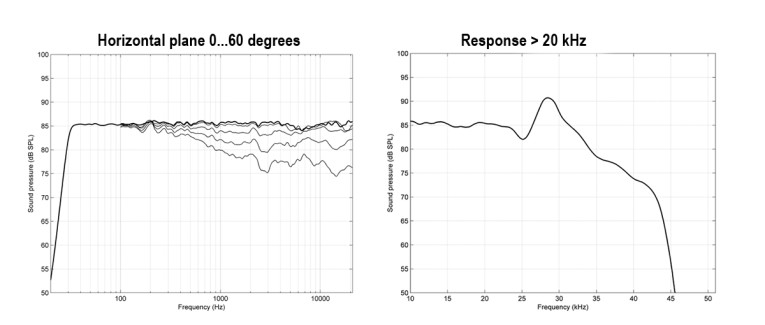
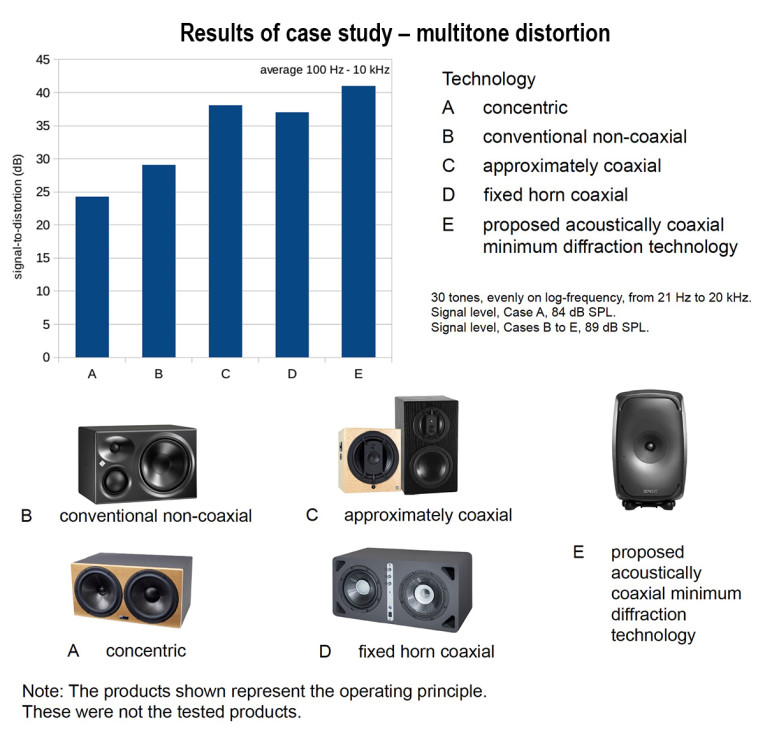
Applications
Acoustically coaxial minimum diffraction design with concealed woofers implies that the three-way monitor can be used equally well in either orientation, vertical or horizontal. The acoustically coaxial three-way monitor’s neutral acoustic character is retained for off-axis directions in either orientation.
Coaxial design also enables the listening distance to be unexceptionally short. The minimum listening distance for the proposed design is smaller than 0.5 m (1.5’). Freedom of orientation with the very short minimum listening distance means that an acoustically coaxial three-way monitor can work in near-field and mid-field applications. The acoustically coaxial three-way monitor is slightly more directional along its long axis. This can provide benefits (e.g., when the console top reflection must be minimized). The monitor can be placed vertically, and the higher vertical directivity reduces the console top reflection level.
Since all the signal processing is done in the digital domain, it allows for excellent frequency response control. The signal processing can be tuned for the installation location and helps in system alignment (see Photo 5). An automated software-based procedure is available for the room alignment and equalization. The flexible room influence compensation reduces room coloration and improves accuracy of monitoring. The compact acoustically coaxial three-way monitor offers a high-quality monitor option for space- or size-limited applications, where normally a two-way monitor would be chosen.
This article was originally published in audioXpress, June 2015.
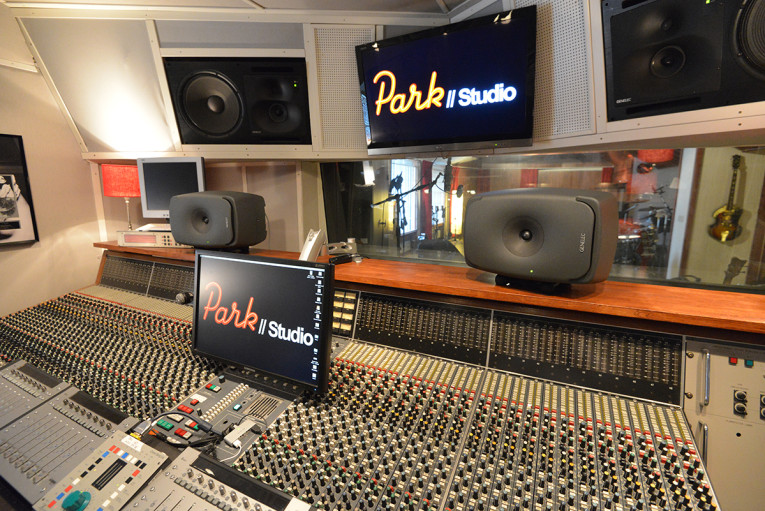
Resources
- Altec Lansing, “DUPLEX Loudspeaker System,” alteclansingunofficial.nlenet.net/Duplex.html, September 2014.
- J. Borwick, Loudspeaker and Headphone Handbook (3rd edition), Focal Press, 2001.
- M. Dodd, “A Wide Dispersion Constant Directivity Dual Concentric Driver,” Convention Paper for the 92th Audio Engineering Society (AES) Convention, Vienna, Austria, March 1992.
- E. Dupont and S. Lipshitz, “Modeling the Intermodulation Distortion of a Coaxial Loudspeaker,” Journal of the Audio Engineering Society (JAES), 2009.
- Genelec, “8351A Three-Amplified SAM Monitor System,” www.genelec.com/8351.
- P. Klipsch, “A Note on Modulation Distortion: Coaxial and Spaced Tweeter-Woofer Loudspeaker Systems,” Journal of the Audio Engineering Society (JAES), 1976.
- Tannoy, “Dual Concentric Loudspeaker Drive Units,” www.44bx.com/tannoy, September 2014.
About the Authors
Ilpo Martikainen is founder and chairman at Genelec. Jussi Väisänen is lead acoustic designer at Genelec. Aki Mäkivirta is the R&D Director at Genelec. Genelec is a manufacturer of active loudspeaker systems based in Iisalmi, Finland. It designs and produces products especially for professional studio recording, mixing and mastering applications, broadcast, and movie production.




